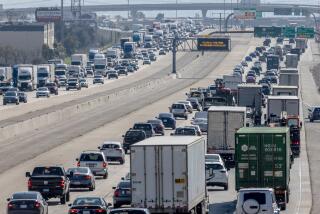China Is Passing Pollution to a New Generation, Study Finds
- Share via
SHENZHEN, China — Paying for the environmental sins of their parents’ generation, nearly two-thirds of the children in this southern Chinese boomtown suffer from lead poisoning, a recent study has shown.
The survey of more than 11,000 local schoolchildren--one of the largest of its kind in China--adds to the mounting evidence of the toll that pollution is taking on the world’s most populous country, even as officials in Shenzhen spend millions of dollars promoting the city as an environmental model.
After 20 years of breakneck development, China has become a land of major ecological damage, a nation where millions of residents gasp for breath, where rivers flow with harmful chemicals and where green spaces are shrinking at an alarming rate.
Rapid industrialization and market reforms have pulled hundreds of millions of Chinese out of abject poverty. But they have also given rise to one of the most polluted nations in the history of the planet.
The long-term effects of such pollution are now coming into focus. The study in Shenzhen demonstrates how the nation’s children are often most at risk and how the negative consequences of dirty air and water extend beyond the present generation to the next.
From October to December last year, researchers with the Shenzhen branch of the Chinese Medical Assn. conducted lead tests on 11,348 local children.
They discovered that 65% of the youngsters had concentrations of lead in their systems that exceeded the level considered safe by the World Health Organization.
Left unchecked, lead poisoning can damage a person’s nervous and reproductive systems, and cause anemia and high blood pressure.
In children, the effects can be worse, including irreversible brain damage, mental retardation, behavioral problems and stunted growth. Anecdotal evidence suggests that such problems are on the rise among Chinese youth, although there are no hard data yet. Extremely severe cases of lead poisoning can result in convulsions, coma or death.
Children are particularly susceptible to lead poisoning because of their height: Lead is more heavily concentrated in the air near the ground. They also breathe in high amounts of car exhaust. And they are more likely to put objects tainted with lead in their mouths.
“It’s easy for it to accumulate and develop into lead poisoning,” said Wu Yulin, one of the directors of the Shenzhen study. “And because it’s a slow process, it’s hard for people to detect right away.”
The cumulative effect was apparent in Wu’s study, which showed that the older the children, who ranged in age from 3 to 15, the more lead in their bodies.
The results of his survey follow similarly grim findings in recent years in cities around China.
In Beijing, experts found excessive lead levels in about 20% of the city’s youngsters last year. An earlier study in Taiyuan, the gritty, industrial capital of central Shanxi province, uncovered a lead-poisoning rate of 64%.
And in Guangzhou, one of Shenzhen’s fellow cities in Guangdong province--China’s richest, most developed region--a survey two years ago indicated that up to 83% of youngsters were suffering from excessive lead.
Extrapolating from various studies, experts estimate that lead poisoning could afflict half of all urban Chinese youth, the official Life Times newspaper reported Friday.
Alarmed by the gathering weight of evidence, the Chinese government is embarking on an investigation of 8 million to 10 million children nationwide to determine the extent of the problem.
“The government needs to stress ... prevention of lead poisoning as soon as possible,” Wu said.
The World Bank has identified lead poisoning as the No. 1 environmental disease among children in the developing world. But the problem isn’t confined to poor nations. In the late 1970s, nearly 90% of American children had elevated lead levels in their blood. That has dropped to less than 5% in the last decade, according to the Centers for Disease Control and Prevention. The dramatic reduction in the U.S. was attributed in large part to the switch to unleaded gasoline.
In China’s rapidly developing cities, exhaust fumes remain one of the biggest sources of lead in the air. The country has been phasing in unleaded gas over the past five years, but in spotty fashion: In Beijing, 30% of the gas used is estimated to fall short of the government’s environmental standards.
Shenzhen is home to more than half a million automobiles, up from practically zero two decades ago. Anointed by the late leader Deng Xiaoping as one of China’s “special economic zones,” Shenzhen has exploded from a sleepy fishing village of 30,000 people into a bustling metropolis of 3 million.
Its environment has suffered in the process.
Power plants and textile factories in some parts of the city sully the air, belching out toxic fumes from their smokestacks. Sewage, dyes and other chemicals get dumped directly into the Pearl River estuary.
Yet at the same time, China nominated Shenzhen this year to the U.N. Environmental Program’s Global 500 Roll of Honor, a showcase of the world’s 500 most environmentally progressive cities.
It was accepted. The UNEP said that Shenzhen had made great strides in cleaning up its act; it congratulated the city government on vetoing 3,619 projects that failed to meet environmental requirements and on investing $461 million in protection measures.
Zhang Xiaobin, publicity director of the Shenzhen Environmental Protection Bureau, acknowledged that his city is not perfect. But he insisted that Shenzhen had distinguished itself as a model for others.
“When you judge the environment of a place,” he said, “you should look at the overall situation.”
More to Read
Sign up for Essential California
The most important California stories and recommendations in your inbox every morning.
You may occasionally receive promotional content from the Los Angeles Times.














